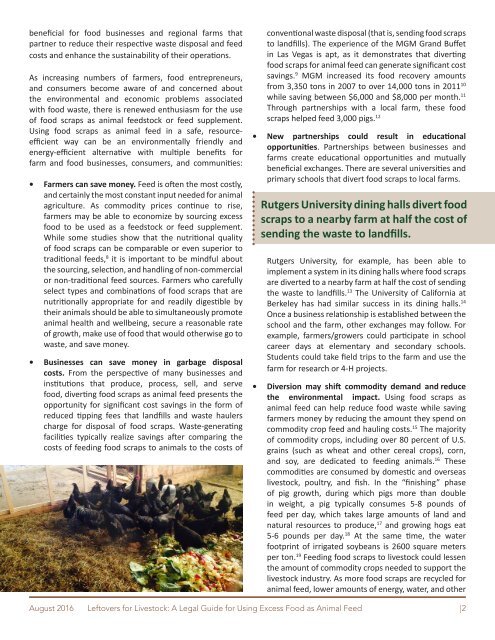LEFTOVERS FOR LIVESTOCK
Leftovers-for-Livestock_A-Legal-Guide_August-2016
Leftovers-for-Livestock_A-Legal-Guide_August-2016
You also want an ePaper? Increase the reach of your titles
YUMPU automatically turns print PDFs into web optimized ePapers that Google loves.
eneficial for food businesses and regional farms that<br />
partner to reduce their respective waste disposal and feed<br />
costs and enhance the sustainability of their operations.<br />
As increasing numbers of farmers, food entrepreneurs,<br />
and consumers become aware of and concerned about<br />
the environmental and economic problems associated<br />
with food waste, there is renewed enthusiasm for the use<br />
of food scraps as animal feedstock or feed supplement.<br />
Using food scraps as animal feed in a safe, resourceefficient<br />
way can be an environmentally friendly and<br />
energy-efficient alternative with multiple benefits for<br />
farm and food businesses, consumers, and communities:<br />
• Farmers can save money. Feed is often the most costly,<br />
and certainly the most constant input needed for animal<br />
agriculture. As commodity prices continue to rise,<br />
farmers may be able to economize by sourcing excess<br />
food to be used as a feedstock or feed supplement.<br />
While some studies show that the nutritional quality<br />
of food scraps can be comparable or even superior to<br />
traditional feeds, 8 it is important to be mindful about<br />
the sourcing, selection, and handling of non-commercial<br />
or non-traditional feed sources. Farmers who carefully<br />
select types and combinations of food scraps that are<br />
nutritionally appropriate for and readily digestible by<br />
their animals should be able to simultaneously promote<br />
animal health and wellbeing, secure a reasonable rate<br />
of growth, make use of food that would otherwise go to<br />
waste, and save money.<br />
• Businesses can save money in garbage disposal<br />
costs. From the perspective of many businesses and<br />
institutions that produce, process, sell, and serve<br />
food, diverting food scraps as animal feed presents the<br />
opportunity for significant cost savings in the form of<br />
reduced tipping fees that landfills and waste haulers<br />
charge for disposal of food scraps. Waste-generating<br />
facilities typically realize savings after comparing the<br />
costs of feeding food scraps to animals to the costs of<br />
conventional waste disposal (that is, sending food scraps<br />
to landfills). The experience of the MGM Grand Buffet<br />
in Las Vegas is apt, as it demonstrates that diverting<br />
food scraps for animal feed can generate significant cost<br />
savings. 9 MGM increased its food recovery amounts<br />
from 3,350 tons in 2007 to over 14,000 tons in 2011 10<br />
while saving between $6,000 and $8,000 per month. 11<br />
Through partnerships with a local farm, these food<br />
scraps helped feed 3,000 pigs. 12<br />
• New partnerships could result in educational<br />
opportunities. Partnerships between businesses and<br />
farms create educational opportunities and mutually<br />
beneficial exchanges. There are several universities and<br />
primary schools that divert food scraps to local farms.<br />
Rutgers University dining halls divert food<br />
scraps to a nearby farm at half the cost of<br />
sending the waste to landfills.<br />
Rutgers University, for example, has been able to<br />
implement a system in its dining halls where food scraps<br />
are diverted to a nearby farm at half the cost of sending<br />
the waste to landfills. 13 The University of California at<br />
Berkeley has had similar success in its dining halls. 14<br />
Once a business relationship is established between the<br />
school and the farm, other exchanges may follow. For<br />
example, farmers/growers could participate in school<br />
career days at elementary and secondary schools.<br />
Students could take field trips to the farm and use the<br />
farm for research or 4-H projects.<br />
• Diversion may shift commodity demand and reduce<br />
the environmental impact. Using food scraps as<br />
animal feed can help reduce food waste while saving<br />
farmers money by reducing the amount they spend on<br />
commodity crop feed and hauling costs. 15 The majority<br />
of commodity crops, including over 80 percent of U.S.<br />
grains (such as wheat and other cereal crops), corn,<br />
and soy, are dedicated to feeding animals. 16 These<br />
commodities are consumed by domestic and overseas<br />
livestock, poultry, and fish. In the “finishing” phase<br />
of pig growth, during which pigs more than double<br />
in weight, a pig typically consumes 5-8 pounds of<br />
feed per day, which takes large amounts of land and<br />
natural resources to produce, 17 and growing hogs eat<br />
5-6 pounds per day. 18 At the same time, the water<br />
footprint of irrigated soybeans is 2600 square meters<br />
per ton. 19 Feeding food scraps to livestock could lessen<br />
the amount of commodity crops needed to support the<br />
livestock industry. As more food scraps are recycled for<br />
animal feed, lower amounts of energy, water, and other<br />
August 2016 Leftovers for Livestock: A Legal Guide for Using Excess Food as Animal Feed |2


